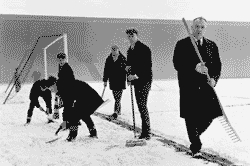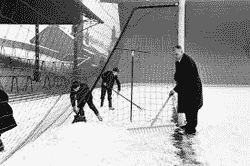
As we have seen with the latest fuss over Premier League matches being scheduled for Christmas Eve in 2017, league football has a complex love hate relationship with Christmas and the holiday period.
Historically the working man had very few days off and little or no paid holidays. The only exception was Christmas and Easter. The two highest aggregate days for league football attendance are Boxing Day and the following replacement bank holiday in 1949.
As Christmas Day fell on a Sunday in 1949 the Football League scheduled three full days of matches in all four divisions. Christmas Eve on the Saturday attracted 950,411 people to 43 league games, giving a respectable average attendance of 22,103. Having nearly a million people watching league football on a Saturday is something we have not seen in the 21st century.
In 1949 Christmas Day fell on a Sunday, which meant the next two days were bank holidays. Boxing Day Monday saw a new record for a one day attendance of 1,235,318 to watch 44 league games giving an average attendance of 28,075. This beat the previous record from October 1948 by 65,000.
Burnley and Newcastle United in the First Division saw their largest home gates for the season. Boxing day also saw bumper crowds in the Second Division. Barnsley, Brentford, Leicester City and Preston North End all recorded their largest gates for 1949-50 season.
370,549 people watched the 11 scheduled matches in the Second Division which was also a new record. The average gate for the Second Division of 33,686 would be a respectable figure for the Premier League now.
This as it turned out was a prelude to the following day. Bank holiday Tuesday saw a new record one day attendance of 1,279,470 beating the previous day by 45,000. The 44 league games had an average attendance of 29,079. Four clubs in the First Division Aston Villa, Liverpool, Middlesbrough and Stoke City saw their biggest gates of the season. Both Arsenal and Aston Villa had gates over 60,000. The First Division average gate was 47,972 a staggering figure compared to even the Premier League of today.
The Second Division broke the day attendance record again with another bumper day. Three clubs Sheffield United, Hull City and Leeds United had gates of over 45,000. The lower leagues also saw bumper gates. All of the Third Division South games bar one saw five figure gates. Nottingham Forest entertaining high flying Norwich City saw 31,844 in this Third Division South match.
Third Division North had 6 matches with 5 figures, two over 20,000. New league leaders Doncaster Rovers drew with New Brighton in front of 23,381. Both Southport and Tranmere Rovers saw their largest gates of the season.
The most surprising fact of this record day was that amongst all these high attendances only Middlesbrough broke their ground attendance record. As far as attendances go 1949, was the high water mark for the popular Christmas league programme.
Boxing Day has always been part of the fixture list, but in the early part of the 20th Century, Christmas Day was also important. The last Christmas Day fixture was during the 1965-66 season when Blackpool played Blackburn Rovers at Bloomfield Road. This was the only Christmas Day fixture in the 1960’s.
Traditionally the FA Cup has always avoided Christmas. Before League football, clubs up and down the land usually played friendly games against local rivals during the holiday period. When the league started in 1888-89 the majority of league clubs carried on playing their and so it seemed natural when league football started matches should be scheduled for these days. Though in 1888-89 the majority of league clubs played their traditional friendly matches against local rivals over the festive period. They had no league games scheduled on Christmas Day 1888, all league clubs played against local rivals.
The first Boxing Day of the first league season saw two league games scheduled. Bolton Wanderers hosted Derby County, whilst West Bromwich Albion tried to stop the onward march of an unstoppable Preston North End. Both clubs enjoyed encouraging if not outstanding attendance.
The following season saw the first Christmas Day fixture when league leaders Preston North End beat Aston Villa, but this was the only one. Boxing Day saw 4 scheduled matches involving two thirds of clubs in the league. Wolverhampton Wanderers v Blackburn Rovers saw the highest league gate of the season in 19,000. This was the match that showed that Christmas football could be popular.
Christmas football was firmly established in the 1890-91 season. A full league fixture list was scheduled for Boxing Day Friday and only the weather got in the way of the full programme being played. Boxing Day was now firmly established in the league programme, but Christmas Day took a bit longer to get established.
By the 1893-94 both Christmas Day and Boxing Day were firmly established in the programme.
Though Christmas Day gates were encouraging especially Woolwich Arsenal versus Burslem Port Vale breaking the five figure barrier, the first Second Division match to do so Boxing Day 1893 saw some clubs enjoying their largest gates of the season.
Boxing Day became the most popular day to watch football when on Boxing Day 1896 saw the record aggregate attendance of 162,500. Boxing Day had arrived and it would not be knocked off its throne. The Bank Holiday Monday 1897 broke that record with 176,348. Boxing Day 1903 saw more than a quarter of a million people watch league football on a single day with an aggregate 251,124.
Christmas Day stayed the poor relation of Boxing Day. That was until the 1908-09 season. Christmas Day and Boxing Day fell on Friday and Saturday that season and Christmas Day became the new aggregate record holder with 372,452 watching league football. The First Division saw Bradford City versus Bristol City, Everton versus Notts County and Newcastle United versus Manchester United top out at 35,000, whilst 28,000 watched the Sheffield derby at Owlerton. In the Second Division 24,000 watched Oldham versus Tottenham Hotspur, the outstanding gate of the division.
This record stood for only 24 hours. Saturday and Boxing Day on the same day, brought a record 440,457 aggregate attendance. Three First Division matches Chelsea versus Manchester City, Manchester United versus Newcastle United and the Sheffield derby at Bramall Lane saw gates of around 40,000. Two Second Division matches Tottenham Hotspur v Oldham Athletic and West Bromwich Albion versus Birmingham saw gates on or over 35,000. This new aggregate record stood for 2 years before the aggregate attendance for Boxing Day 1910 hit a new high of 452,801.
The most famous Christmas Day football matches were the ones allegedly played on the Western Front between opposing armies in 1914. During the regular 1914-15 season played during the first year of the war, there was a full programme of matches on Christmas Day. One match Newcastle United versus Sunderland attracting a crowd of 40,000. The total for both divisions was 260,000 about 100,000 less than Christmas Day 1913. Boxing Day 1914 had nearly 140,000 less spectators than the previous year.
And this is how it remained until after the Great War of 1914-18. With the end of the war and the resumption of league football saw the next record aggregate of 488,134 for Boxing Day 1919.
With the expansion of league football after the war from two leagues to three leagues and then four leagues meant that many records were up for grabs. The new four division football league record was set on Boxing Day 1920 at 952,955. This was in turn bettered by a Boxing Day 1929 total of 964,293.
Having one million people watch league football was finally achieved and again on a Boxing Day this time Boxing Day 1936 when 1,040,564 people watched 42 league games. First Division Everton at home to league leaders Arsenal attracted 59,440. More than 50,000 watched Manchester City play Middlesbrough. Second Division Aston Villa attracted 54,690 people to watch them beat Swansea Town 4-0. Nearly 30,000 people watched the Wrexham versus Chester derby match in the Third Division North. Wales also hosted the highest Third Division South when 31,594 watched Cardiff City versus Walsall.
This figure represented a high water point for football league attendance. It took the Secord World War and the post war football boom to beat the 1936 record. Again it was a Boxing Day schedule for 1946. Boxing Day 1946 saw 1,065,150 only 25,000 higher than the previous record. Christmas fixture lists during the post war boom years were largely hampered by bad weather during the cold snaps of the late 1940’s.
The high point of Christmas football of course during the 1949-50 season. Christmas Day was still established part of the programme but it was during the 1950’s that this day became less popular as a day to watch league football. Christmas Day, calendar and weather permitting, stayed part of the football league fixture list. What spelt the end of Christmas Day fixtures was the end of the Third Division North and South and the advent of Third Division and Fourth Division in 1957-58. This cut down on the number of clubs playing in the same league that were within close proximity. Also travelling also became more difficult as many transport systems shut down on Christmas Day.
Boxing Day remains extremely popular amongst football fans, but with the increasing number of foreign owners, managers and players from countries that shut down over the festive period, the will be a rising demand within the football hierarchy to also follow suite. This would be a sad turn of events for English league football because Boxing Day in particular is always a favourite time watch football and the holiday atmosphere is unrivalled.
If English league football does decide to start to have a winter break it will have lost a series of matches that are unique, exciting and just plain happy. Let us all hope Christmas league football is here to stay.
David Coalman December 2017



